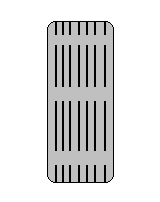Checking Tread Wear
*EASY*
When checking your tire pressure, you should also examine the depth of tire tread across the entire tire surface. Use a penny to determine the remaining tread depth at its shallowest point. Insert the penny in a tread groove so Lincoln's head is toward the tire. If the top of Lincoln's head can be seen, the tread is worn thin and the tire must be replaced. However, it is best to measure remaining tread with an actual tread depth gauge. The minimum safe tread depth is 1/16". Technically, a tire is worn out if any two adjacent tread grooves are 1/16" deep or less. If any tire indicates this condition, have the tire replaced.
Tread wear should be even across the tire, but slight differences are permissible, particularly with front wheel drive cars. If tread wear is significantly greater at the sides of tire than at its center, and proper tire pressure has been maintained, the vehicle most likely needs repair of suspension components, a front wheel alignment, tire balancing or tire rotation. Have the problem indicated by abnormal tire wear corrected immediately.
Tread wear indicators will appear as horizontal 1/2" wide rubber strips perpendicular to the tire tread grooves when 1/16" of tread groove remains.

TREAD WEAR INDICATOR
If these treadless areas appear on your tire, have the tire replaced. Do not wear down a tire until the inner cords or plies show. Note that bias ply tires commonly exhibit step wear due to the nature of their construction. In essence, the 2nd and 6th tread ribs (second from the inside of each edge) wear more quickly and become slightly shorter than the other tread ribs because they deflect more and scrub the pavement. This should not be a cause of great concern.